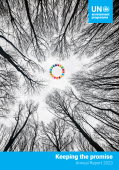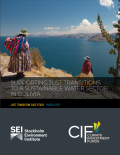
According to the UN Office for Disaster Risk Reduction, resilience is the ability of a system, community or society to resist, absorb, accommodate and recover from the effects of a hazard in a timely and efficient manner, while preserving its essential basic structures and functions. Humankind faces a growing number of risks – climate change, conflict, depletion of natural resources, natural disasters, economic crisis, epidemic diseases – and other risk factors such as urbanisation and ageing populations. Because of the interconnected nature of such risks and the recognition that they often cannot be eliminated entirely, the integration of resilience into development planning has become essential.
In the context of green growth, resilience can be strengthened by multiple channels: economic diversification, ecosystem preservation, energy security, sustainable production and consumption, resource efficiency and increased resources for dealing with uncertainties. Systematically implemented, green growth strategies can be powerful and resilient in face of risks, mitigating the adverse effects of shocks, and enabling communities to meet growing demand for shelter, energy, food, transport and water.
Relevance to the SDGs
The concept of resilience is incorporated in a number of the Sustainable Development Goals (SDGs). SDG 2 calls for resiliency in agricultural systems, SDG 9 in infrastructure and SDG 11 in human settlements or cities.
Explore green growth resources related to the SDGs:
SDG 2.4
Resilient agriculture SDG 9.1
Resilient infrastructure SDG 11.b
Resilient Cities
The finance and insurance sectors have an important role to play in helping companies address some of the risks associated with climate change and unsustainable natural resource extraction. These risks include transition risks (such as changing technology, business models and consumer demands from the transition to a low-carbon economy), water-related risks (such as water pollution, water scarcity, and flooding), resource-related risks (including stranded assets and scarcity of certain minerals), and natural capital-related risks (such as ecosystem degradation, deforestation, air pollution, and soil nutrient loss). Some of these risks are diversifiable for the finance sector but many are systemic and impossible to avoid.
The need to build resilience to a broad suite of shocks and the importance of better risk management are also impacting development finance. The UN’s Addis Ababa Agenda creates a new global framework for development finance by considering a much broader approach to financing sustainable development and by recognizing the importance of the private sector in delivering more resilient development, by increasing awareness of risks and encouraging mitigation from companies and governments as a condition of financing. The insurance sector in particular offers important resilience and risk management products, providing timely post-crisis finance. Catastrophe bonds can serve a similar purpose in providing much needed liquidity in the immediate aftermath of shocks.
Climate change and the current consumption of natural resources presents a number of growing risks for businesses, with insurance studies finding that 78% of SMEs expect climate change-associated risks to have a significant effect on their business. These risks include water-related risks (such as water pollution, water scarcity, and flooding), resource-related risks (including stranded assets and scarcity of certain minerals), and natural capital-related risks (such as ecosystem degradation, deforestation, air pollution, and soil nutrient loss).
Businesses can prepare for and mitigate these risks by undertaking risk assessments. For instance, the Natural Capital Coalition has developed a Natural Capital Protocol that helps companies identify, measure, and assign a value to their direct and indirect impacts on natural capital in order to make fully-informed decisions.










